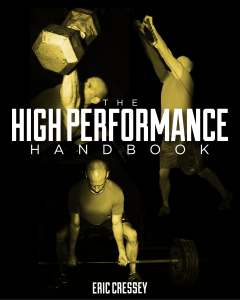
Weight Training Programs: 7 Ways to Get Strong(er) Now
When it comes to intermediate to advanced lifters and their weight training programs, they don’t just want to get strong; they want to get strong fast.
With that in mind, I’m devoting today’s post to some of my favorite strategies to increase strength quickly. I talk a lot about longer-term strength and conditioning strategies, but figured it’d be a good idea to highlight some “quick fixes” today.
1. Warm-up – This seems like a no-brainer, but you’d be amazed at how many people jump right into their weight training program of the day without even getting their body temperature up. It’s well documented that performance improves as core body temperature rises. However, as this study demonstrated, even a lowered skin temperature can decrease force output – independent of core body temperature. So, it may be advantageous to start your day’s strength training program in long sleeves and remove layers as you go. I prefer to see folks sweating by the time the warm-up ends; set aside at least ten minutes for it so that you can get some foam rolling and mobility drills in.
This is why every training session in Show and Go begins with foam rolling and a dynamic warm-up.
2. Hydrate – You’d be amazed at how many people – both athletes and non-athletes – are chronically dehydrated. Research at my alma mater, The University of Connecticut, demonstrated that dehydration negatively impacted performance – especially on subsequent sets. In other words, dehydrated lifters don’t bounce back as quickly between sets. As an interesting aside, everyone on this study was either a classmate or professor of mine; cool (no pun intended) stuff!
Regardless, drink as much as you think you need to drink – and then drink some more.
3. Have Some Caffeine – I don’t love the idea of guys crushing energy drinks like the world is about to end and they don’t need their adrenal glands anymore, but a little boost here and there can do the trick for a lot of lifters. On the whole, research supports the idea that caffeine improves performance in most scenarios with minimal risk, provided the dose isn’t excessive and the individual isn’t prone to certain issues (migraines being the one that comes to mind the quickest).
Think of it as a “here and there” boost, but don’t assume that you need to crush it to be successful. Many people get enough of it in from drinking coffee in the morning that they’re desensitized, anyway. I’d prefer folks drink coffee, anyway, as it’s loaded with antioxidants and actually confers more health benefits than folks realize.
4. Firm up your Grip – It drives me bonkers when I see a lifter get all fired up to take a big lift, and then grab the bar with a limp hand. There are times to be gentle – handling puppies, performing surgery, and knitting scarves, for instance – but lifting heavy stuff is not one of those times. A firm grip do so much more than connect you to the bar; it turns on more proximal muscles and gets the nervous system going, as we have loads of mechanoceptors in our hands (disproportionately more than other areas on the body). As an example, physical therapist Gray Cook often cites a phenomenon called “irradiation,” where the brain signals the rotator cuff to fire as protection to the shoulder when it’s faced with a significant load in the hand, as with a deadlift. Just grabbing onto something get more muscles involved in the process.
5. Tinker with Technique – It goes without saying that just a few subtle strength exercise technique adjustments can make a big difference quickly. Using the deadlift as an example, the few I know that can make a dramatic difference quickly are:
a) bringing the hands in closer (shortens the distance the bar must travel)
b) taking off the shoes, or getting into a pair of minimalist training shoes (also shortens the distance the bar must travel, and puts the weight on the heels, where you want it)
c) spending less time in the bottom position before one pulls (notice in the video below that I get my thoughts together, then dip, grip, and rip; it allows me to get a bit more out of the stretch-shortening cycle at the bottom):
These are just a few coaching cues for a single strength exercise, but there are countless more unique to each individual to help people increase strength quickly.
6. Change the Music – I don’t need to cite a study to prove to you that lifting with good music will help your cause, but I will anyway: Music (or the expectation of music) makes cyclist work harder. Cycling isn’t lifting heavy stuff, but it goes without saying that my experience has been that folks get strong faster when they’ve got music playing and lots of energy in the gym.
7. Utilize Post-Activation Potentiation – This is a fancy way of saying that if you lift (or even just hold) a heavier weight, when you subsequently (shortly thereafter) perform a comparable exercise with a lighter weight, it will feel easier. In the research, it works in some scenarios, but not in others (seems to be more effective in the lower body than the upper body). Chad Waterbury covered this concept in some detail HERE, if you’re interested in reading more.
These are just seven strategies you can employ in your weight training programs to increase strength transiently, and there are surely many more. By all means, share your top short-term “get strong fast” strategies in the comments section.
Looking for a weight training program where you can best put these strategies in action? Check out The High Performance Handbook.




